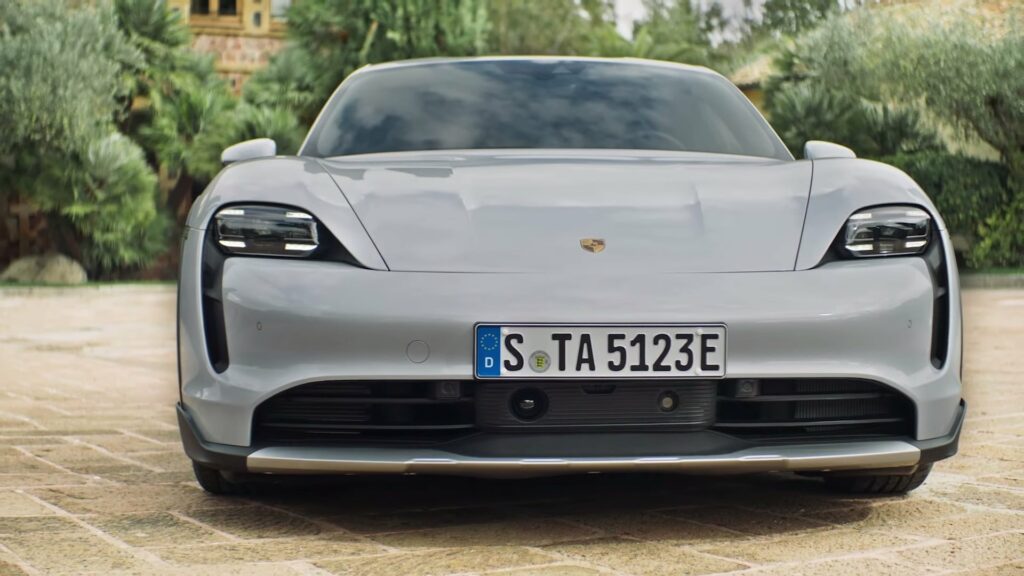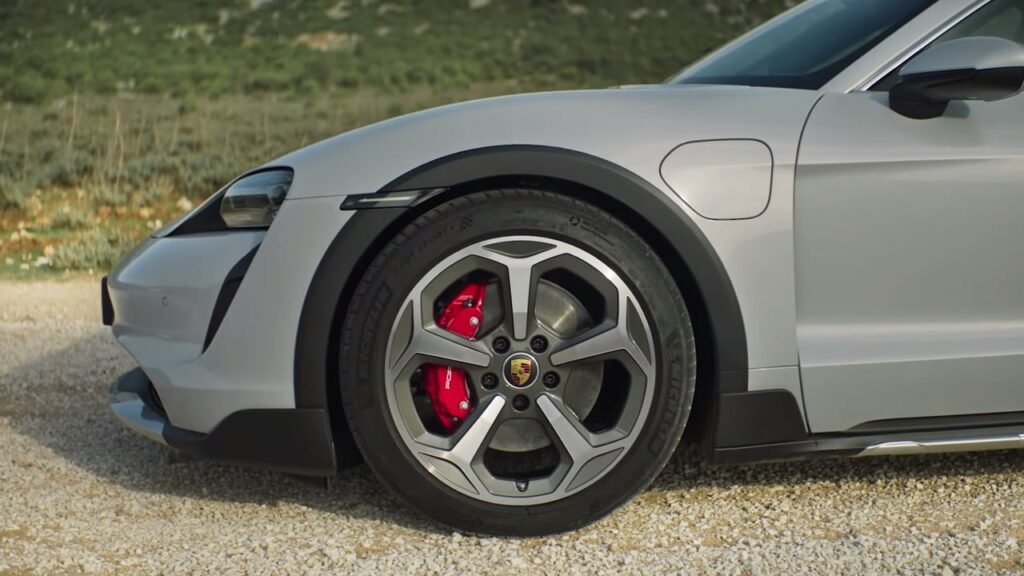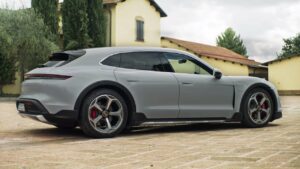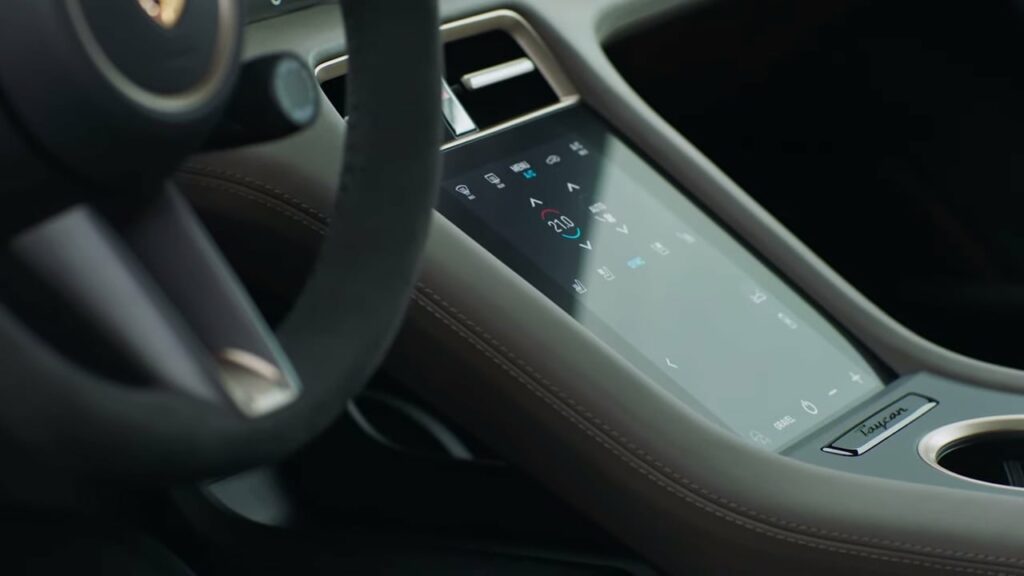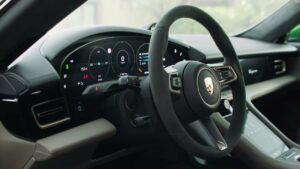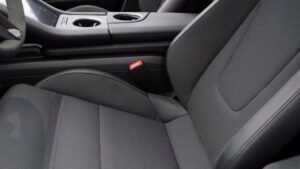Porsche Taycan Turbo
The Porsche Taycan Turbo is Porsche’s electric sports car that offers a unique level of innovation in electric powertrains and marks the manufacturer’s era of transition from traditional combustion engine models to advanced eco-friendly vehicles.

The powertrain of the Taycan Turbo includes two permanent magnet synchronous electric motors, one on each axle, which produce a total continuous power of 460 kW (625 hp) or 500 kW (680 hp) and 850 N⋅m of torque through a two-speed gearbox mounted on the rear axle using Launch Control. The top speed of the electric car is 260 km/h and the acceleration to 100 km/h is 3.2 seconds.
Using a centralized chassis management system, the Taycan Turbo is able to analyze and synchronize each axle in real time. Two electric motors provide the car with electric all-wheel drive, which interacts with the advanced Porsche Dynamic Chassis Control Sport body roll stabilization technology as well as the adaptive three-chamber air suspension and electronically controlled shock absorber to provide the car with a stable, extremely comfortable ride at full power.

The Taycan Turbo features a 93.4 kW⋅h battery pack that can be charged from 5 to 80% capacity in 22.5 minutes using 270 kW fast charging stations.
With 11 kW AC power sources, it takes 9 hours to charge an electric car at 100% capacity. Fast charging stations of 50 kW take 93 minutes to charge the battery from 5 to 80%. The full battery capacity provides the electric car with a range of up to 450 km in the mixed WLTP cycle.
The electric car can only be attributed to Porsche because of its familiar silhouette, although it may be the company’s first hard-to-recognize car.

The unusualness of the exterior design is that the car seems unusually wide and in part extremely flat. This is due to the peculiarity of the powertrain, which requires special attention to aerodynamic performance, as well as the layout of the battery and the electric drive.
The electric car is four-door and has two luggage compartments, which makes it many times more practical than a conventional Porsche.

While the Taycan Turbo has retained the company’s styling on the outside, inside is a completely new car from another era, where digital technology reigns supreme and there’s no room for the analog atavisms of the internal combustion engine era.
Simultaneously on the torpedo is a 16.8-inch all-digital instrument panel display with four display options, a 10.9-inch central multimedia display, and a third personal passenger display. The center tunnel is fully touch-screen, and most of the electric car’s functions can be controlled with a voice assistant.

The Porsche Taycan Turbo has an unusual “chip” arrangement for the rear passengers, the so-called “foot garage” – a special recess in the battery (where the feet of the rear passengers are located), which increases rear seating comfort and allows for a low car height.
| Performance | |
| Acceleration 0 – 100 km/h | 3.2 sec |
| Top Speed | 260 km/h |
| Electric Range | 400 km |
| Total Power | 500 kW (680 PS) |
| Total Torque | 850 Nm |
| Drive | AWD |
| Battery and Charging | |
| Battery Capacity | 93.4 kWh |
| Battery Useable | 83.7 kWh |
| Europe | |
| Charge Port | Type 2 |
| Port Location | Right Side – Front |
| Port Location 2 | Left Side – Front |
| Charge Power | 11 kW AC |
| Charge Time (0->400 km) | 9 hours |
| Charge Speed | 45 km/h |
| Fastcharge Port | CCS |
| FC Port Location | Right Side – Front |
| FC Port Location 2 | – |
| Fastcharge Power (max) | 262 kW DC |
| Fastcharge Time (40->320 km) | 19 min |
| Fastcharge Speed | 880 km/h |
| Energy Consumption | |
| EVDB Real Range | |
| Range | 400 km |
| Vehicle Consumption | 209 Wh/km |
| CO2 Emissions | 0 g/km |
| Vehicle Fuel Equivalent | 2.4 l/100km |
| WLTP Ratings (TEL) | |
| Range | 452 km |
| Rated Consumption | 229 Wh/km |
| Vehicle Consumption | 185 Wh/km |
| CO2 Emissions | 0 g/km |
| Rated Fuel Equivalent | 2.6 l/100km |
| Vehicle Fuel Equivalent | 2.1 l/100km |
| WLTP Ratings (TEH) | |
| Range | 383 km |
| Rated Consumption | 266 Wh/km |
| Vehicle Consumption | 219 Wh/km |
| CO2 Emissions | 0 g/km |
| Rated Fuel Equivalent | 3.0 l/100km |
| Vehicle Fuel Equivalent | 2.5 l/100km |
| TEL = Test Energy Low | TEH = Test Energy High | |
|
Rated = official figures as published by manufacturer. Rated consumption and fuel equivalency figures include charging losses.
|
|
|
Vehicle = calculated battery energy consumption used by the vehicle for propulsion and on-board systems.
|
|
| Real Energy Consumption between 151 – 289 Wh/km | |
| City – Cold Weather | 217 Wh/km |
| Highway – Cold Weather | 289 Wh/km |
| Combined – Cold Weather | 246 Wh/km |
| City – Mild Weather | 151 Wh/km |
| Highway – Mild Weather | 226 Wh/km |
| Combined – Mild Weather | 186 Wh/km |
| Energy use for each trip will vary considerably depending on the driver and the conditions. Therefore, we have provided a range of estimates which can be useful in developing an understanding of the potential benefits of this technology. | |
| Safety (Euro NCAP) | |
| Adult Occupant | 85% |
| Child Occupant | 83% |
| Rating Year | 2019 |
| Vulnerable Road Users | 70% |
| Safety Assist | 73% |
| Dimensions and Weight | |
| Length | 4963 mm |
| Width | 1966 mm |
| Width with mirrors | 2144 mm |
| Height | 1381 mm |
| Wheelbase | 2900 mm |
| Weight Unladen (EU) | 2380 kg |
| Gross Vehicle Weight (GVWR) | 2880 kg |
| Max. Payload | 575 kg |
| Cargo Volume | 366 L |
| Cargo Volume Max | No Data |
| Cargo Volume Frunk | 84 L |
| Roof Load | 75 kg |
| Tow Hitch Possible | No |
| Towing Weight Unbraked | 0 kg |
| Towing Weight Braked | 0 kg |
| Vertical Load Max | 0 kg |
| Miscellaneous | |
| Seats | 4 people |
| Isofix | Yes, 2 seats |
| Turning Circle | 11.7 m |
| Platform | VW J1 |
| Car Body | Sedan |
| Segment | F – Luxury |
| Roof Rails | No |
| EV Dedicated Platform | Yes |
Home and Destination Charging (0 -> 100%)
A public charging station is required to use the highest possible charging rate. The EVSE/charging station’s charging capacity affects how long it takes to fully charge the battery. The table below shows all possible options for fully charging the Porsche Taycan Turbo.
In Europe, plugging an electric car into an outlet is often as easy as plugging it into a household outlet, but there are differences from country to country. The table below shows the different ways to charge the Porsche Taycan Turbo, but in some countries some chargers may not be available.
Type 2 ( IEC 62196)

| Charging Point | Max. Power | Power | Time | Rate |
| Standard 11.0 kW On-Board Charger | ||||
| Wall Plug (2.3 kW) | 230V / 1x10A | 2.3 kW | 43 hours | 9 km/h |
| 1-phase 16A (3.7 kW) | 230V / 1x16A | 3.7 kW | 26h45m | 15 km/h |
| 1-phase 32A (7.4 kW) | 230V / 1x32A | 7.4 kW | 13h30m | 30 km/h |
| 3-phase 16A (11 kW) | 400V / 3x16A | 11 kW | 9 hours | 44 km/h |
| 3-phase 32A (22 kW) | 400V / 3x16A | 11 kW | 9 hours | 44 km/h |
| Optional 22.0kW On-Board Charger | ||||
| Wall Plug (2.3 kW) | 230V / 1x10A | 2.3 kW | 43 hours | 9 km/h |
| 1-phase 16A (3.7 kW) | 230V / 1x16A | 3.7 kW | 26h45m | 15 km/h |
| 1-phase 32A (7.4 kW) | 230V / 1x32A | 7.4 kW | 13h30m | 30 km/h |
| 3-phase 16A (11 kW) | 400V / 3x16A | 11 kW | 9 hours | 44 km/h |
| 3-phase 32A (22 kW) | 400V / 3x32A | 22 kW | 4h30m | 89 km/h |
Fast Charging (10 -> 80%)
If you want to enjoy driving an electric car, one of the most important features to consider is the number of miles per hour the car can travel while charged. This is called the “range” of the car. All electric cars have a certain range, even if they are 100% charged. This is because they do not have an internal combustion engine to lean on if you need to drive a long distance.
Max. Power: The maximum power provided by the charging point
Avg. Power: The average power provided by the charging point during a session of 10% to 80%.
Time: the time it takes to charge from 10% to 80%
Speed: the average charging rate during the session of 10% to 80%
Combined Charging System (CCS Combo 2)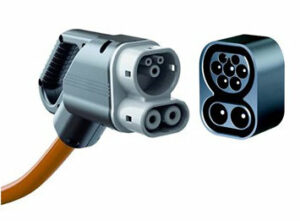
| Charging Point | Max. Power | Avg. Power | Time | Rate |
| CCS (50 kW DC) | 50 kW | 50 kW | 74 min | 220 km/h |
| CCS (175 kW DC) | 166 kW | 157 kW | 24 min | 700 km/h |
| CCS (350 kW DC) | 262 kW | 197 kW | 19 min | 880 km/h |
| Brand | Porsche |
| Model | Taycan Turbo |
| Body Style | Sedan |
| Car Engine | 500 |
| Motor power | 850 |
| Battery Energy, kWh | 93.4 |
| Power reserve (NEDC/EPA/WLTP), km | - / - / 400 |
| Level Charging (230/400/DC), hours | - / 4.3 / 0.19 |
| Electrical Acceleration, 0-100 km/h (0-62.1 mph) in sec | 3.2 |
| Top Speed, km/h | 260 |




